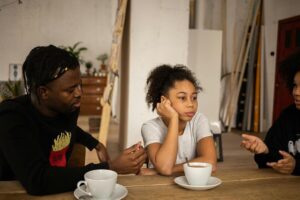When parents come to me with questions, they often begin with: “I’ve talked to them about this!” or “We sat down and I told them it’s not okay to do that”. By the time they recount their lecture to me, they are exasperated (and so is their child!). But why? Why can’t we simply tell kids how to behave and they’ll listen?
My hope is to answer this question and lead you to a different way of getting through to your kid. One that doesn’t leave you hoarse and your child defensive.
Kid’s Brains Are Still Under Construction
Imagine trying to download a massive file onto a tiny, old hard drive. That’s like an adult trying to lecture a kid. Children, especially younger ones, have limited information processing capacities. Their working memory – the mental “notepad” where they hold information– can only manage a few pieces of information at a time. A long lecture overwhelms this capacity, causing them to tune out or miss important details. They grasp snippets but the big message gets lost.
The Disconnect Between Perceived and Actual Learning
As adults, we often equate talking to our children with them learning from us. We deliver the information, and in our minds, the transaction is complete. They might nod, look like they’re listening, or even repeat back a few words. But this passive approach to teaching doesn’t equal learning.
True learning involves active engagement, understanding, and filtering new information into existing knowledge. When we lecture, we deprive children of the opportunity for this active processing. They might be present physically, but mentally, they’ve checked out. Think about Charlie Brown and the adults in his world. Their voices sound like muffled drawls; much like how we sound to our kids who don’t yet have the cognitive architecture to understand long lectures.
Emotional Barriers To Listening
Kid’s brains are still under construction, we get that. But their emotions also impact their listening. Certain communication styles can trigger defensive reactions that shut down learning altogether.
Defensive Responses to Lecturing
Think of the last time someone lectured you. How did you feel? Were you able to listen, fully listen? Or did you notice your own defenses creeping in. Like adults, kids have their own defenses they fall back on when they feel defenseless. Think of your child’s go-to protective strategies as you read over these common ones:
- Shut down: They become unresponsive, withdrawn, or appear blank, avoiding eye contact.
- Argue or justify: They interrupt, offer excuses, or try to turn the tables, trying to defend themselves rather than listen.
- Become defiant: They might outright refuse to comply or intensify the behavior they’re being lectured about, seeing it as a power struggle.
- Internalize shame: For sensitive children, lectures can lead to feelings of inadequacy, guilt, or shame, damaging their self-esteem and future willingness to communicate openly.
As you can imagine, none of these responses are conducive to behavioral change. Or learning, for that matter.
Why Do We Lecture When We Know It Doesn’t Work?
So if we know that lecturing is ineffective, why do we keep doing it?
Lectures as Emotional Release for Adults
Sometimes, a lecture isn’t just about the child; it’s about our own emotions. We might be frustrated, angry, scared, or exhausted. Delivering a long explanation can feel like a way to release our emotions, to feel like we’re “doing something” about the situation. It offers us a sense of control when we feel overwhelmed. Rather than teaching our child a new way of operating, lectures erode relationships by heightening our child’s defenses.
The Misplaced Good Intentions
We lecture kids because we care about them. We want them to learn right from wrong, to understand consequences, to avoid making the same mistakes, and to grow into responsible adults. We believe that by providing all the information, all the reasons, and all the warnings, we are equipping them for success. We often communicate the way we were communicated with, or the way we believe adults should communicate. Our intentions are pure, but our methods are often misaligned with how children actually learn and process information.
Alternatives to Lecturing
Moving beyond lectures requires a shift in mindset and a willingness to embrace more child-friendly communication strategies.
Active Learning Approaches
Instead of passively receiving information, children learn best by actively participating. This means:
- Hands-on experiences: Allowing children to learn through doing, experimenting, and exploring.
- Problem-solving together: Presenting a challenge and guiding them to find solutions rather than dictating them.
- Role-playing: Practicing social skills or difficult situations in a safe, interactive way.
These approaches engage multiple senses, make learning concrete, and empower children to come to their own understanding.
Here are a few things to keep in mind when move away from lecturing:
Question-Based Guidance
Instead of telling kids what to do, get them thinking by asking a question. Open-ended questions encourage children to think, reflect, and share their own understanding. And they put kids in a position of empowerment rather than criticism. For example, instead of “You shouldn’t have done that because it hurts people’s feelings,” try “What do you think happened when you said that? How do you think that made [person] feel?”
Brief, Impactful Communication
In play therapy we have a favorite phrase: “Communicate in 10 words or less, otherwise don’t say it”. Less is often more. Deliver messages with clarity. Focus on one key point at a time. Use simple language. This respects their limited processing capacity and avoids overwhelming them. A short, calm statement followed by a natural consequence is far more effective than a lengthy lecture.
Implementing Better Communication in Everyday Family Life
Changing how we operate is hard work. Here are some ways we can increase our chances of doing things differently:
Regular Family Meetings
Even short, informal family meetings can be powerful. This is a designated time for everyone to share, discuss challenges, and find solutions together. It teaches active listening, respectful disagreement, and shared responsibility, turning potential lecture moments into opportunities for collective problem-solving.
Creating Learning Moments Through Real-Life Experiences
The best learning happens organically, within the context of everyday life. Use teachable moments as they arise, but approach them with curiosity and guidance rather than judgment. If a child spills milk, instead of lecturing about being careful, calmly ask, “What do we need to do now to clean this up?” and guide them through the process. The focus shifts from blame to solution.
Navigating Common Lecture-Triggering Scenarios
When a child misbehaves, take a breath. Instead of reacting immediately with a lecture, try:
- Describing what you see: “I see your blocks are all over the floor.”

- Stating your feelings (without blame): “I’m frustrated because I can’t walk through the room safely.”
- Stating a need or expectation: “I need the blocks to be picked up before dinner.”
- Offering a choice (if appropriate): “Would you like to pick them up now, or would you like to take a break and come back to them in five minutes?”
- Implementing a natural or logical consequence: If the blocks aren’t picked up, perhaps they aren’t available for play for a set period.
This approach maintains boundaries, teaches responsibility, and avoids the defensive emotional reaction that lectures inevitably provoke.
Making Meaningful Connections
By shifting away from lengthy monologues and towards active engagement, thoughtful questioning, and brief, impactful messages, we can help our children learn new ways of behaving. Perhaps even more importantly, when we stop lecturing we make room for meaningful connection with our child.
Blog written by Sentier therapist Lily Ferreira, MSW, LICSW, RPT.
Sources
Arduini, N. (n.d.). Information Processing Theory | Child Psychology. Lumen Learning. Retrieved June 23, 2025, from https://courses.lumenlearning.com/child/chapter/information-processing-theory-2/
Landreth, G. L. (2002). Play therapy: The art of the relationship (2nd ed.). Brunner-Routledge.
Question based learning: importance and role for children’s education. (n.d.). kinderpedia. Retrieved June 23, 2025, from https://www.kinderpedia.co/en/school-and-nurseries-resources/blog/early-childhood-education/question-based-learning
UNICEF. (n.d.). The Art of Parenting Training Guide. https://www.unicef.org/lac/media/27656/file/The%20Art%20of%20Parenting.pdf





